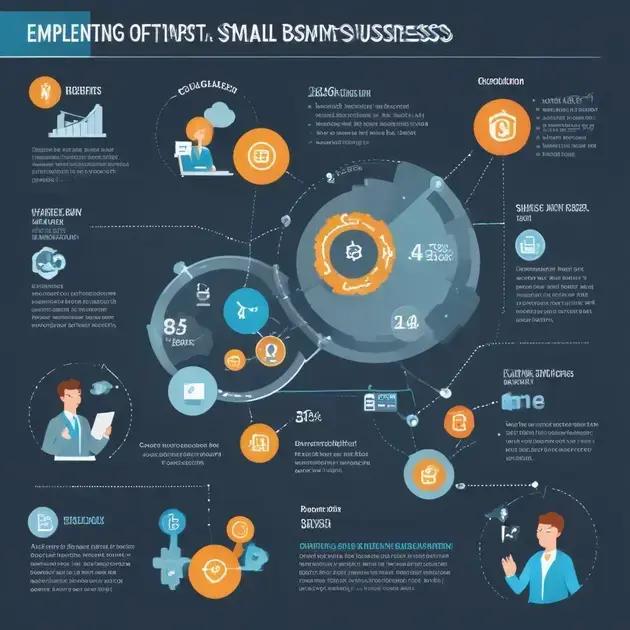Implementing effective systems for small businesses enhances efficiency, improves communication, and ensures consistent quality. Assessing needs, choosing compatible tools, and providing thorough training are essential for successful adoption and integration.
Systems for small business play a critical role in the efficiency and productivity of operations. In today’s fast-paced market, these systems can ultimately determine whether a business thrives or struggles. This article dives into understanding what systems are available, their benefits, and how to choose and integrate them successfully.
Understanding Systems for Small Business
Understanding Systems for Small Business is essential for any entrepreneur looking to streamline their operations and enhance efficiency. Systems are frameworks that help manage various aspects of a business, including processes, technologies, and personnel. By implementing effective systems, small businesses can operate more smoothly and effectively.
Types of Systems
There are several types of systems that small businesses can adopt. Management systems organize the business structure, while operational systems focus on daily tasks. Financial systems ensure that resources are allocated appropriately, and customer relationship management (CRM) systems help businesses engage with their clients.
Importance of Systems
Having clear systems in place is crucial. It allows employees to understand their roles and responsibilities, reducing confusion and errors. Moreover, systems support the standardization of processes, leading to consistent outcomes and improved quality of service.
Implementing Systems
To implement systems effectively, start by evaluating the specific needs of your business. Identify the processes that require improvement and consider software solutions that can provide the necessary support. Engage your team in this process to ensure everyone understands the changes being made.
Monitoring and Improvement
After systems are in place, it’s important to monitor their performance regularly. Gather feedback from your team and clients, and be open to making adjustments as necessary. Continuous improvement is key to maximizing the benefits that systems offer.
By understanding and effectively implementing systems for your small business, you position yourself for greater success, allowing for sustainable growth and an improved competitive edge.
Key Benefits of Implementing Systems

Key Benefits of Implementing Systems in small businesses can greatly impact overall efficiency and effectiveness. Systems streamline operations, leading to improved productivity and better resource management.
Enhanced Efficiency
One of the primary benefits of systems is enhanced efficiency. By automating routine tasks and standardizing processes, employees can work faster and more accurately. This efficiency reduces the overall time taken to complete tasks, allowing businesses to serve more customers and increase their output.
Improved Communication
Systems also foster improved communication among team members. With clear protocols and tools in place, employees can share information easily and collaborate effectively. This minimizes miscommunication and ensures everyone is on the same page, boosting teamwork.
Consistent Quality
Implementing systems ensures consistent quality in products and services. Standard operating procedures help maintain the same level of quality across different operations. Customers receive the same experience each time, enhancing their satisfaction and loyalty.
Data Management and Analysis
Systems for small businesses often include components for data management. This allows companies to collect, store, and analyze data efficiently. Understanding patterns and trends helps in making informed decisions, leading to better strategic planning.
Scalability
As businesses grow, having established systems makes scaling easier. New employees can be onboarded quicker, and processes can be replicated without a hitch. This scalability prepares a business for expansion without compromising service quality.
Choosing the Right Systems
Choosing the Right Systems for your small business is critical to achieving operational success. It’s important to take the time to evaluate options and select systems that meet your specific needs.
Assess Your Business Needs
Begin by assessing what your business truly needs. Consider the processes that require improvement and the areas where efficiency can be enhanced. This will help you focus on solutions that address your most pressing challenges.
Research Available Systems
Conduct research on the various systems available in the market. Look for software solutions that specialize in small business needs, such as accounting software, project management tools, or customer relationship management (CRM) systems. Read reviews and case studies to understand how these systems have benefited others.
Consider Scalability
As your business grows, your systems should be able to grow with you. Choose scalable solutions that can adapt to increasing demands without requiring a complete overhaul. This will save time and resources in the long run.
Evaluate User-Friendliness
The best system for your business is one that your team can easily use. Look for intuitive interfaces and features that simplify operations. User-friendly systems require minimal training and can significantly improve adoption rates among employees.
Budget Considerations
Lastly, consider your budget when choosing systems. Analyze the total cost of ownership, including initial costs, ongoing subscriptions, and potential hidden fees. Look for solutions that offer good value while meeting your needs.
How to Integrate Systems Effectively

How to Integrate Systems Effectively in your small business is crucial for maximizing their benefits. A smooth integration can enhance productivity while minimizing disruption.
Plan Before You Start
Before integrating any new systems, it is essential to have a clear plan. Identify the objectives you wish to achieve, and evaluate how the new systems will fit into your existing processes. Involve your team in the planning process to gain insights and foster buy-in.
Choose the Right Tools
Select tools that are compatible with your existing systems. Integration software can help create connections between different applications, ensuring data flows seamlessly. Look for solutions that offer user-friendly interfaces and robust support.
Training and Support
Provide comprehensive training to your staff on the new systems. Training sessions should cover functionalities, best practices, and troubleshooting. This preparation helps ensure employees are confident and competent in using the systems effectively.
Monitor the Integration Process
Once the systems are integrated, closely monitor their performance. Use metrics to evaluate how well the systems are meeting your goals. Collect feedback from your team to address any challenges they face.
Continuous Improvement
Integration is not a one-time task. It requires ongoing evaluation and adjustment. Stay open to making improvements to the systems to better fit your evolving business needs. Regularly review all systems to ensure they continue to work together efficiently.
Common Challenges in Adopting Systems
Common Challenges in Adopting Systems can hinder the smooth transition to new processes in small businesses. Understanding these challenges helps in planning for effective solutions.
Resistance to Change
Many employees may feel uncomfortable with changes in their routine. Resistance to new systems is a common challenge. It is crucial to communicate the benefits of the new systems clearly and involve your team in the transition process. Encouragement and support can help reduce anxiety.
Integration Issues
Integrating new systems with existing processes can be complex. Compatibility problems may arise when linking different software and databases. It is important to assess compatibility before implementation and seek tools that easily integrate with your current systems.
Lack of Training
Without proper training, staff may struggle to use new systems effectively. This can lead to frustration and lower productivity. Providing comprehensive training sessions is essential to ensure everyone is comfortable and capable of utilizing the systems.
Cost of Implementation
Adopting new systems can be expensive, especially for small businesses with limited budgets. Consideration of the total cost of ownership, including implementation, maintenance, and potential upgrades, is necessary for making informed decisions about adopting new systems.
Data Migration Challenges
Transferring data from old systems to new ones can create challenges. Data loss or corruption can occur during migration. It is important to create a detailed data migration plan that includes backup solutions and strategies to ensure data integrity.
In Summary: Utilizing Systems for Small Business Success
Implementing effective systems is critical for small businesses looking to improve efficiency and productivity. By understanding the available systems, assessing your needs, and overcoming common challenges, your business can thrive.
From enhancing communication to ensuring consistent quality, the benefits of adopting the right systems are numerous. Work towards integration in a mindful way, provide necessary training, and monitor system performance regularly to achieve the best results.
Ultimately, with the right approach, systems can revolutionize your small business, making you more competitive and paving the way for future growth.
FAQ – Frequently Asked Questions About Systems for Small Businesses
What are the main benefits of implementing systems in my small business?
Implementing systems can improve efficiency, enhance communication, ensure consistent quality, and support data management and analysis.
How do I choose the right systems for my business?
Assess your specific needs, research available options, consider scalability, evaluate user-friendliness, and analyze your budget before making a decision.
What common challenges might I face when adopting new systems?
Common challenges include resistance to change, integration issues, lack of training, cost of implementation, and data migration difficulties.
How can I effectively train my staff on new systems?
Provide comprehensive training sessions that cover the new systems’ functionalities and best practices, and encourage questions and feedback during the process.
Is it important to monitor the performance of new systems?
Yes, regularly monitoring system performance allows you to address issues, gather employee feedback, and make necessary adjustments for continuous improvement.
How can I ensure the successful integration of new systems into my existing operations?
Start with a detailed plan, choose compatible tools, involve your team in the integration process, and be open to continuous evaluation and improvement.




